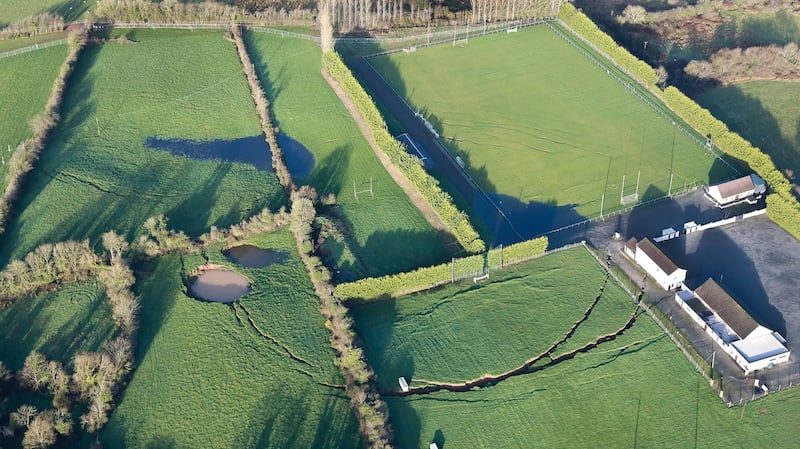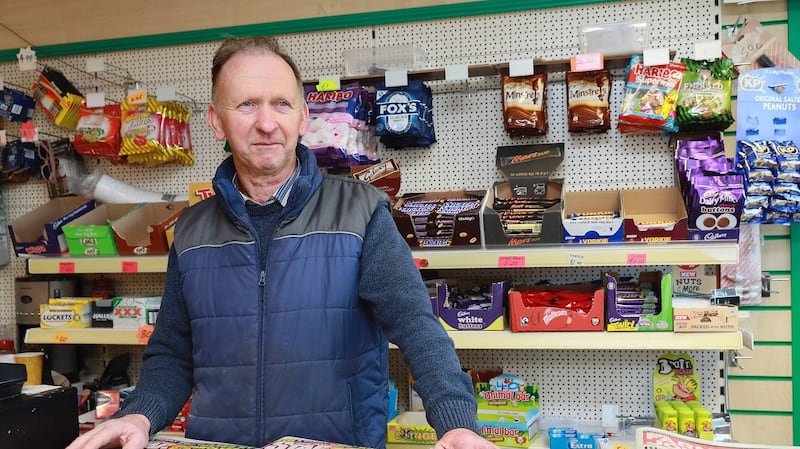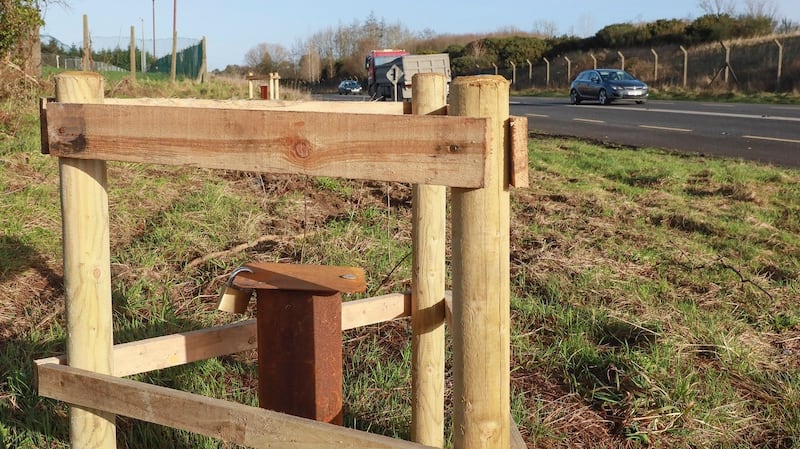When Damien Martin's father moved into his modest, 1950s-style bungalow on the side of the old R179 Carrickmacross to Kingscourt road in Co Monaghan, he probably didn't think a lot about the 250-million-year-old red mudstone and gypsum deposits buried deep beneath his feet.
Nor could he possibly have envisaged the climate change that, more than half a century later, would produce a summer of exceptional drought, the knock-on effects of which would impact his son’s family.
The lack of rain earlier last year saw the river Bursk shrink in volume, and in June, when the gypsum miners had to deal with a temporary excess of sulphate-laden water in one part of the mine (which they would normally do by pumping it into the river – safely and under Environmental Protection Agency licence), they channelled it instead into abandoned mine shafts, some 60m-70m underground.
They had done this before without adverse consequences, though not on this scale. Excess mine water is normally discharged into the river at a rate that does not cause environmental damage, but this can only be done when there is a sufficient volume of river water – an option not available last summer.

Within three months of the mine water being stored in the disused mine, several of the slender, 12m-high underground pillars holding up the disused tunnels collapsed, the mud foundations in which they sat weakened by the liquid.
It was only a matter of time before the collapse deep underground had a serious knock-on effect on the surface above.
Damien Martin's late parents' home (as well as his own newer, two-storey house beside it and his cabinet-maker's shed) is perched on land by the edge of the large pit, known as Knocknacran Open Cast Mine, from which today's gypsum has been extracted by quarrying since the late 1980s.
The disused tunnels and shafts of the old mine, which closed around the same time, radiate out from the pit, traversing beneath the surrounding countryside.
The Martin's property is separated from the Magheracloone Community Centre and football pitch by the modern R179, a wide, two-lane carriageway with hard shoulder that shears through the landscape.
After the collapse deep underground, the surface of Magheracloone Mitchells GAA pitch beside the community centre also began to subside. A giant, saucer-shaped depression, 350m in diameter and 5ft deep, appeared, etched on to the grass in deep, jagged, crevasse-like rips in the soil.
Two community centre buildings soon had gashes running up their sides – cracks so pronounced it looked like the structures could collapse at any minute.
With such a long mining history, it is not surprising that much of the land above the old mine is pock-marked from subterranean collapses
“We couldn’t believe it,” Martin said this week, standing in the driveway of his and his parents’ former home. “It was astonishing, and as the day wore on it became more serious.”
That was Monday, September 24th, and while initially hopeful it would be safe to remain in their home, by Friday the mining company, Gyproc, convinced the family they would be better off moving to Carrickmacross into a house (whose rent the company would pay) until whatever was going on underground was better understood.
Since then he; his wife, Angela; and children, Alan, Conor and Sinéad; have been living in the town.
“We’ll probably be there till March,” says Martin, grateful for the help given by Gyproc but anxious to return home, where he continues to go daily to work.
Century of mining
The people of Carrickmacross in Co Monaghan and Kingscourt in Co Cavan, and the townlands between, have been living with gypsum extraction for a century and more.
Gyproc, now owned by Compagnie de Saint-Gobain, a French construction giant, has been active in Monaghan since the 1930s and a clay pit, not far from the large, open-cast gypsum mine, linked to Kingscourt Brick (now owned by the UK-based Breedon Group), is evidence of long-standing local links with construction.

With the gypsum extraction, people from across Cavan, Monaghan, Meath and Louth, and in the immediately adjoining mining townlands of Drumgossatt, Knocknacran, Magheracloone, Drummond and Clonseady, often found jobs for life with Gyproc and other firms doing business with it.
Today some 220 people work for the company locally – about 30 of them extracting the raw material from the open-cast pit opposite the community centre, 140 of them at the large plant in Co Meath, just south of Kingscourt, where the quarried gypsum is turned into plasterboard, and the remainder elsewhere, including at its Dublin headquarters.
The company has deep roots in the community. It was already in talks with the GAA club and the centre to buy the property and help fund new pitches and sporting facilities as part of a wider €20 million investment programme in the area.
Company sources say they are acutely aware of the anxieties of local people and praise what they see as their “exceptional patience” since September’s events. They say they see those people living near the mine as their neighbours.
While glaciation sculpted the Cavan/Monaghan landscape into boulder clay drumlins and the lakes they often help create, underground man has left his mark, and decades of mining is reflected in local culture.
The poetic and prosaic
The late Padraig McGrane, a Magheracloone poet, wrote in his poem Maps of youthful memories playing in the mine – "a dark shaft sloped precipitously through red earth", he recalled – four children 50ft underground walking along shafts extending four miles through the earth, "with fingers fanning blasted rock ... worked by men from farming stock".
Padraig's brother Mícheál, a mushroom grower and shopkeeper in Drumgossatt, chairs a newly assembled committee of anxious residents who next Tuesday are due to meet David Maxwell, chairman of Monaghan County Council, and its chief executive, Eamonn O'Sullivan, together with the six members of the Carrickmacross-Castleblayney municipal district, Aiden Campbell, Colm Carthy, Jackie Crowe, Noel Keelan, Padraig McNally, and PJ O'Hanlon. The Drumgossatt and Knocknacran Residents group represents 13 homes in the area most immediately affected and is looking for reassurance.

Representatives of Gyproc; the exploration and mining division of the Department of the Environment; and two engineering consultant companies, SRK and Wardell Armstrong, are also due to meet council officials on the same day but it is not clear if they – or any of them – will also be at the meeting with residents.
With such a long mining history, it is not surprising that much of the land above the old mine is pock-marked from subterranean collapses. Large tracts of south Co Monaghan, including the gypsum mining area, are underpinned by Carboniferous limestone.
Sinkholes, caused by subterranean water eroding limestone leading to surface collapses, are not uncommon. Collapsed man-made cavities create what are known as crown holes, but the two types are essentially the same, in effect and appearance.
Community concerns
In the immediate aftermath of the September land collapse at the community centre and GAA grounds, part of the R179 was closed between Drumgossatt crossroads and the Mace filling station at Drummond, as well as the local road L4900 from the R179 to Drumgossatt village.
Concerns at that time centred on the safety of the two roads, five homes and access to Drumgossatt national school. The R179 was deemed safe and reopened fully soon after but the L4900 remained closed for some eight weeks.
The company sent information leaflets to householders, explaining what was happening. Inspection holes were bored around the collapsed ground and instruments lowered to confirm the state of structures below.
For 26 years, Geraldine Ward has been living, with her partner and their two children, in a bungalow beside the school and overlooking the junction of the L4900 as it enters the village. Beneath the adjoining field are six shafts from the closed mine, she says.
“There’s one next to our garage,” she says, based on a map she saw many years ago.
She takes Gyproc assurances about safety with a pinch of salt.
“There no accountability,” she says. “Where there’s a mine, there’s a risk.”
SRK Consulting assessed the situation on behalf of Gyproc and identified the pumped-in water as the likely cause of the collapse. SRK said the collapse was contained within the area immediately under the football pitch and that the ground beneath the two roads was stable.

An assessment of SRK’s work was then carried out by UK firm Wardell Armstrong on behalf of the Government. It came to essentially the same view as SRK.
Nonetheless, five families moved out of their homes on the advice of Gyproc and the council. One returned a week later but four were put up in Carrickmacross, where the Martins remain for now.
Life appeared to be returning to normal when, on December 19th, a new crown hole appeared beside the L4900 about 400m north of the collapsed community centre land.
The following day council officials decided to close the road. Engineers say the new hole is unrelated to the nearby large-scale collapse, but the L4900 was closed and has remained closed.
Mícheál McGrane wants it reopened as soon as possible and is worried about the long-term stability of the main R179 road.
“That main road is undermined, completely undermined, for about a kilometre,” he says. That means there’s pillars and mine ruins under it.”
'We are working with them to ensure that any claims from these residents are dealt with as quickly as possible'
In meeting the council next week and pressing Gyproc, he is thinking long term.
“The aim is to have safe roads for the community, for the school and that people who were put out of their houses are looked after properly.”
While he remains optimistic for the future and retains a faith in the bona fides of all concerned, Ward is more sceptical.
“I want a public inquiry,” she says. “As far as I am concerned, the mining is a cancer in our parish and it is slowly gnawing away at us.”
Damien Martin, fittingly for a marathon runner, takes the long view and wants to get back to normal.
“It’s a bit of a mess [living in Carrick and commuting daily to his workshop],” he says. “I can’t wait to get home again.”
Gyproc’s response
In a lengthy statement to The Irish Times, Gyproc outlined its response to recent events, both its engagement with local people, external consultants and the statutory authorities, including the Government and Monaghan County Council.
The company apologised to residents for what they had had to put up with.
“Gyproc fully recognises that while these matters are not unusual in mining, these events do impact the local community,” the company said.
“We apologise for the upset caused by road closures and loss of access to facilities. Gyproc has a long and respected mining history in the area for over 80 years and we will continue to work with our neighbours and our wider community in a collaborative and transparent manner to resolve any concerns we can . . .
“Our primary initial focus was on supporting the families in the five homes that were originally included in the precautionary area of investigation. We have completed the geological studies of any impact of mine workings on those properties and engaged structural engineers to review each dwelling, sharing the outcome of those reports with each resident or their representatives.
“Some residents have since returned to their homes, while some have chosen not to. Where residents have chosen not to return to their homes, we have supported them with alternative accommodation.
“We do understand and appreciate the difficulties they have faced and have met with all parties, and our family liaison officer remains in place to continue to support them when needed. We are working with them to ensure that any claims from these residents are dealt with as quickly as possible.”









